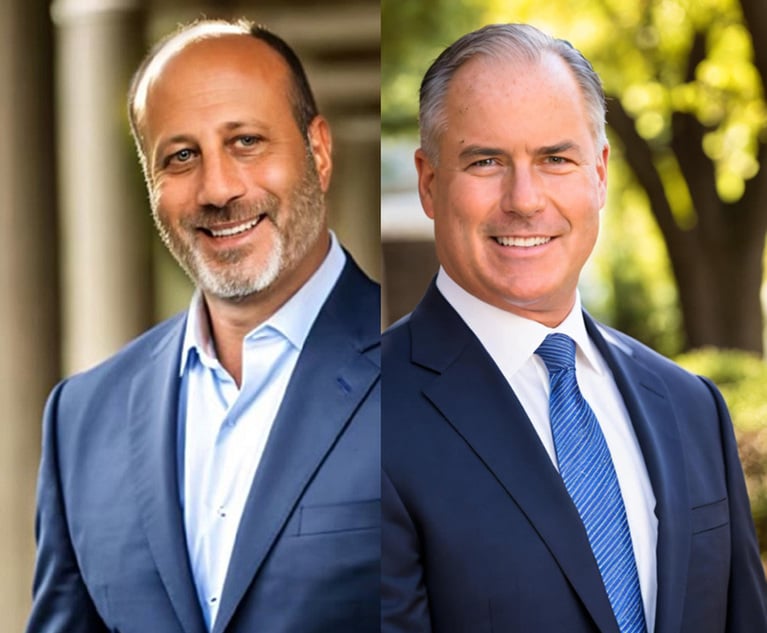 Jason Levine of Hangley Aronchick Segal Pudlin & Schiller. Courtesy photo
Jason Levine of Hangley Aronchick Segal Pudlin & Schiller. Courtesy photo The Staying Power of Small and Midsize Firms
For the firms that seek to maintain long-term independence, remaining true to who they are and their original goals helps ensure their staying power, allowing them to remain a consistent partner to clients.
August 07, 2023 at 10:42 AM
6 minute read
At a time when it seems like every month a law firm acquires or merges with another firm, many small and midsize firms deliberately have stayed off that playing field. There are no shortcuts to managing, growing and maintaining a law firm, and the approach that works for some does not work for all. For the firms that seek to maintain long-term independence, remaining true to who they are and their original goals helps ensure their staying power, allowing them to remain a consistent partner to clients. As we emerge from COVID, legal publications regularly tout the benefits of law firm combinations. But the increasingly popular belief that small and midsize firms must acquire or be acquired is wrong. My firm, Hangley Aronchick Segal Pudlin & Schiller, is an example of why.
Merger Mania
Law firm combinations nationally reached a record high in 2019, just before the pandemic, with 115 deals that year. After fewer combinations in 2020 and 2021 during the height of COVID-19 (67 and 84, respectively), merger activity picked up again in 2022 with 102 deals. So far in 2023, there have been fewer than 50 deals, but merger activity has recently ticked up, and legal analysts predict that mergers will accelerate by the end of 2023 and into 2024. To name just a few examples, earlier this year Detroit-based Clark Hill absorbed litigation boutique Conrad O'Brien and real estate firm Larsson & Scheuritzel, both first-generation, Philadelphia-based firms; and nationally, London-founded Allen & Overy plans to merge with Shearman & Sterling, which would create a behemoth firm of nearly 4,000 lawyers across almost 50 offices worldwide.
This content has been archived. It is available through our partners, LexisNexis® and Bloomberg Law.
To view this content, please continue to their sites.
Not a Lexis Subscriber?
Subscribe Now
Not a Bloomberg Law Subscriber?
Subscribe Now
NOT FOR REPRINT
© 2025 ALM Global, LLC, All Rights Reserved. Request academic re-use from www.copyright.com. All other uses, submit a request to [email protected]. For more information visit Asset & Logo Licensing.
You Might Like
View All

'Taking the Best' of Both Firms, Ballard Spahr and Lane Powell Officially Merge
6 minute read
Law Firms Mentioned
Trending Stories
- 1How ‘Bilateral Tapping’ Can Help with Stress and Anxiety
- 2How Law Firms Can Make Business Services a Performance Champion
- 3'Digital Mindset': Hogan Lovells' New Global Managing Partner for Digitalization
- 4Silk Road Founder Ross Ulbricht Has New York Sentence Pardoned by Trump
- 5Settlement Allows Spouses of U.S. Citizens to Reopen Removal Proceedings
Who Got The Work
J. Brugh Lower of Gibbons has entered an appearance for industrial equipment supplier Devco Corporation in a pending trademark infringement lawsuit. The suit, accusing the defendant of selling knock-off Graco products, was filed Dec. 18 in New Jersey District Court by Rivkin Radler on behalf of Graco Inc. and Graco Minnesota. The case, assigned to U.S. District Judge Zahid N. Quraishi, is 3:24-cv-11294, Graco Inc. et al v. Devco Corporation.
Who Got The Work
Rebecca Maller-Stein and Kent A. Yalowitz of Arnold & Porter Kaye Scholer have entered their appearances for Hanaco Venture Capital and its executives, Lior Prosor and David Frankel, in a pending securities lawsuit. The action, filed on Dec. 24 in New York Southern District Court by Zell, Aron & Co. on behalf of Goldeneye Advisors, accuses the defendants of negligently and fraudulently managing the plaintiff's $1 million investment. The case, assigned to U.S. District Judge Vernon S. Broderick, is 1:24-cv-09918, Goldeneye Advisors, LLC v. Hanaco Venture Capital, Ltd. et al.
Who Got The Work
Attorneys from A&O Shearman has stepped in as defense counsel for Toronto-Dominion Bank and other defendants in a pending securities class action. The suit, filed Dec. 11 in New York Southern District Court by Bleichmar Fonti & Auld, accuses the defendants of concealing the bank's 'pervasive' deficiencies in regards to its compliance with the Bank Secrecy Act and the quality of its anti-money laundering controls. The case, assigned to U.S. District Judge Arun Subramanian, is 1:24-cv-09445, Gonzalez v. The Toronto-Dominion Bank et al.
Who Got The Work
Crown Castle International, a Pennsylvania company providing shared communications infrastructure, has turned to Luke D. Wolf of Gordon Rees Scully Mansukhani to fend off a pending breach-of-contract lawsuit. The court action, filed Nov. 25 in Michigan Eastern District Court by Hooper Hathaway PC on behalf of The Town Residences LLC, accuses Crown Castle of failing to transfer approximately $30,000 in utility payments from T-Mobile in breach of a roof-top lease and assignment agreement. The case, assigned to U.S. District Judge Susan K. Declercq, is 2:24-cv-13131, The Town Residences LLC v. T-Mobile US, Inc. et al.
Who Got The Work
Wilfred P. Coronato and Daniel M. Schwartz of McCarter & English have stepped in as defense counsel to Electrolux Home Products Inc. in a pending product liability lawsuit. The court action, filed Nov. 26 in New York Eastern District Court by Poulos Lopiccolo PC and Nagel Rice LLP on behalf of David Stern, alleges that the defendant's refrigerators’ drawers and shelving repeatedly break and fall apart within months after purchase. The case, assigned to U.S. District Judge Joan M. Azrack, is 2:24-cv-08204, Stern v. Electrolux Home Products, Inc.
Featured Firms
Law Offices of Gary Martin Hays & Associates, P.C.
(470) 294-1674
Law Offices of Mark E. Salomone
(857) 444-6468
Smith & Hassler
(713) 739-1250






